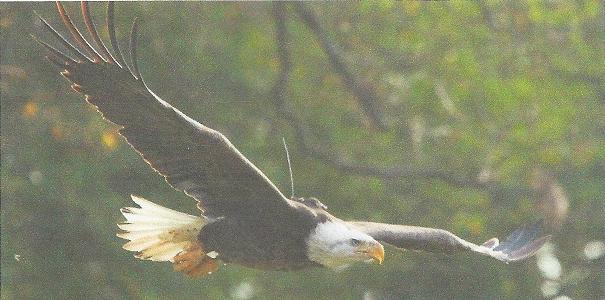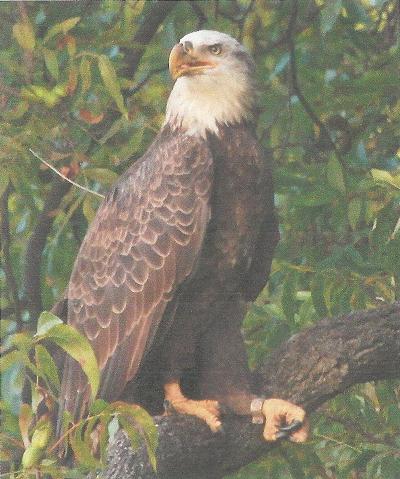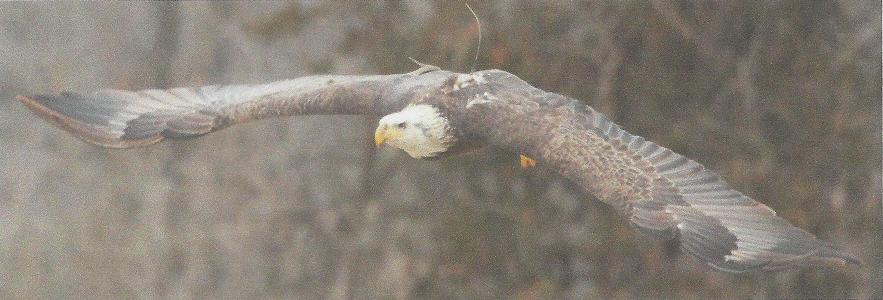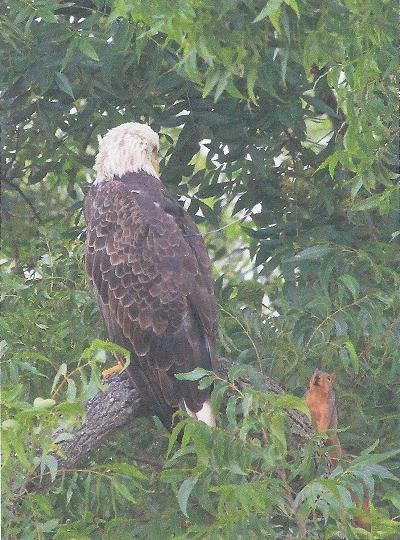 |
Canku Ota
|
 |
|
(Many Paths)
|
||
|
An Online Newsletter
Celebrating Native America
|
||
|
April 2017 - Volume
15 Number 4
|
||
|
|
||
|
Wadasé
Zhabwé
|
||
|
by Citizen Potawatomi
Hownikan
|
||
|
"Originally we intended for her to be one of our education birds,
to train on the glove," recalled CPN Eagle Aviary Director Jennifer
Randell. Yet as the birds went through their vaccination regimen, Randell
and Assistant Director Bree Dunham noted some changes. "We noticed her feathers started coming back in. That was a good sign." said Randell As time passed Penojés began to fly inside the aviary
enclosure, performing figure eight maneuvers above the other eagles.
Following an x-ray, it became clear that the wing injuries had healed
much better than expected and that Penojés had a chance at
becoming fully flighted. Randell and Dunham reached out to the U.S. Fish and Wildlife Service and asked permission to release her, but there was a hitch in the plan. Due to her non-releasable status USFWS was not initially supportive of the release. However, after much discussion and seeing documentation of her current status, they agreed to the proposal. 
Following consultations with USFWS, Randell and Dunham worked
to prepare Penojés for release. She was long-lined and conditioned
to reach her ideal flight weight and strength. She learned to catch
live prey and further demonstrated her ability to survive in the
wild on her own. During this time, the aviary staff also proposed that Penojés
be soft released at the aviary and fitted with a tracking telemetry
to allow them to monitor her progress and study her movements once
in the wild. Having been born in Florida, most raptor experts believed
that even if she was released in Oklahoma, a state where she had
grown up, she might travel back to the Sunshine State. After consultations with other eagle experts across the country,
Randell and Dunham decided to hold off on her release until after
the nesting Oklahoma birds had made their annual migrations. It
was determined to release Penojés in spring 2013. "We wanted to wait until all the Oklahoma birds had fledged and left their nest," said Dunham. "We wanted her to stay and not make her feel like she needed to leave until she was more experienced."
"Stepping" Into The World" Penojés means 'child' in Potawatomi, but for a bird taking her first steps into the world on her own, that name just wasn't going to cut it. "We had to rename her to send her back out into that big world,"
said Randell with pride. "It's rough out there; we wanted her to
have a stronger name, a name that told the story of her journey." With assistance from CPN Tribal Chairman John "Rocky" Barrett,
the CPN Cultural Heritage Center and Language Department, Penojés
was reborn as Wadasé Zhabwé. "It means 'brave breakthrough'. It's hard to put into words,
but it means you've been through struggles and really hard times,
but you've come out strong on the other side. It was a perfect name
for her," said Randell.
Following the fitting of the telemetry tracking backpack with assistance of fellow eagle experts from Sia: The Comanche Nation Ornithological Initiative and Raptor View Research Institute, a hooded Wadasé was placed on a platform standing in the meadow behind the aviary. In anticlimactic fashion, once the hood was removed, Wadasé remained on the platform. "Nothing happened for a few minutes, which seemed like an eternity,"
recalled Randell. After several minutes of surveying her surroundings, Wadasé
took flight across the meadow, eventually landing on a branch along
its tree line where she roosted for the evening. She wouldn't be seen again on the Aviary grounds for nearly
a month. Unbeknownst to Randell before the release, the GPS data from
Wadasé's backpack could only be downloaded from the ARGOS
satellite once every three days. Thanks to some spotting by fellow
tribal employees, reports came back that Wadasé was still
near the tribal complex with sightings at the golf course and other
areas near the Aviary. More than 20 days passed before she made
her way back to the Aviary, where she was spotted under the big
pecan tree out front, healthy but hungry; she eagerly made her way
to the platform once aviary staff provided a meal. "Initially when we released her she would come back every other
day for food, but soon it was once a week, then once a month, then
we didn't see her for six months." Randell pointed out that the employees at the Nation went above and beyond in their willingness to work around the eagle. She noted that those working on construction or maintenance projects did their best to remain quiet in areas where Wadasé was located so as not to frighten her off, making the Aviary grounds a safe place for her initial days and weeks outside the safety of the eagle enclosures. Data That Lasts
Four years later, the pack – roughly the size of a Match
Box car, weighing just 48 grams – has so far remained on the
young adult Wadasé. The data gained from the telemetry has been a wealth of knowledge
about the patterns and habits of young Bald Eagles. Many eagles
travel hundreds if not thousands of miles during migration. "We're fortunate that Wadasé has generally stayed in
a 70-mile radius of the aviary," said Randell with a laugh. Now in her fourth year of life in the wild, Wadasé Zhabwé
is thriving. She no longer depends on the Aviary for support but
she still visits from time to time. There are many, both in and
outside the Nation, who have become avid followers of her progress.
Every third day, Randell and Dunham log on to review the telemetry
data in search of her with as much anticipation as they felt
The Aviary staff is quick to point out without people coming together this release would simply not have been possible. From the Good Samaritan to the dedicated staff at the Audubon Center for birds of Prey, Bill Voelker and Troy of Sia who assisted with her conditioning and release to Rob Domenech from the Raptor View Research Center who came all the way from Montana to band and fit her with telemetry, to the CPN for the support of this program to USFWS for their efforts, those close by who have kept an eye out for her and to everyone who follows her journey. "We just want to thank everyone who made this release not just a possibility but a success," said Dunham. If you would like to follow news of Wadasé or learn more about the CPN Eagle Aviary, visit www.potawatomiheritage.org/#aviary. As always we encourage you to keep your eyes out for Wadasé if you are near the areas she frequents. Send your encounters with Wadasé or any other eagles to us at aviary@potawatomi.org.
|
|||
|
|
|
|
||
|
|
||
| Canku Ota is a free Newsletter celebrating Native America, its traditions and accomplishments . We do not provide subscriber or visitor names to anyone. Some articles presented in Canku Ota may contain copyright material. We have received appropriate permissions for republishing any articles. Material appearing here is distributed without profit or monetary gain to those who have expressed an interest. This is in accordance with Title 17 U.S.C. Section 107. | ||
|
Canku Ota is a copyright ©
2000 - 2017 of Vicki Williams Barry and Paul Barry.
|
||
 |
 |
|
|
The "Canku
Ota - A Newsletter Celebrating Native America" web site and
its design is the
|
||
|
Copyright ©
1999 - 2017 of Paul C. Barry.
|
||
|
All Rights Reserved.
|
||
 Wadasé
Zhabwé,or as she was known then, Penojés, was one
of the first eight eagles to call the CPN Eagle Aviary home. Before
being mature enough to fledge on her own, she'd fallen out of her
nest in Florida in 2012 and was rescued by a Good Samaritan and
taken to the Audubon Center for Birds of Prey in Maitland for treatment.
The fall from the nest fractured her left wrist or wingtip, and
there was evidence something may have attacked her on the ground
as well, causing further tissue damage to the already injured wing.
According to the paperwork the CPN Eagle Aviary received when she
arrived, she would never fly well enough to be considered for release.
Wadasé
Zhabwé,or as she was known then, Penojés, was one
of the first eight eagles to call the CPN Eagle Aviary home. Before
being mature enough to fledge on her own, she'd fallen out of her
nest in Florida in 2012 and was rescued by a Good Samaritan and
taken to the Audubon Center for Birds of Prey in Maitland for treatment.
The fall from the nest fractured her left wrist or wingtip, and
there was evidence something may have attacked her on the ground
as well, causing further tissue damage to the already injured wing.
According to the paperwork the CPN Eagle Aviary received when she
arrived, she would never fly well enough to be considered for release.
 The
day of release, as Randell and Dunham recalled, was one of pent
up emotion. Chairman Barrett held a naming ceremony that morning,
the first for any eagle at the CPN Aviary.
The
day of release, as Randell and Dunham recalled, was one of pent
up emotion. Chairman Barrett held a naming ceremony that morning,
the first for any eagle at the CPN Aviary. With
Wadasé there have been many firsts, including her status
as the first Bald Eagle to be banded and released from a Native
American Aviary with GPS tracking telemetry. Robert Domenech of
Raptor View Research Institute, who fitted Wadasé with the
GPS backpack, admitted that day that while he had experience in
placing the packs on many birds, a Bald Eagle was not one of them.
Wadasé was the first. Given their tendency to be in and around
water, he told Randell he didn't' expect the backpack to remain
on her for more than six months to a year before the cotton stitching
would break down and the unit would naturally fall off.
With
Wadasé there have been many firsts, including her status
as the first Bald Eagle to be banded and released from a Native
American Aviary with GPS tracking telemetry. Robert Domenech of
Raptor View Research Institute, who fitted Wadasé with the
GPS backpack, admitted that day that while he had experience in
placing the packs on many birds, a Bald Eagle was not one of them.
Wadasé was the first. Given their tendency to be in and around
water, he told Randell he didn't' expect the backpack to remain
on her for more than six months to a year before the cotton stitching
would break down and the unit would naturally fall off.